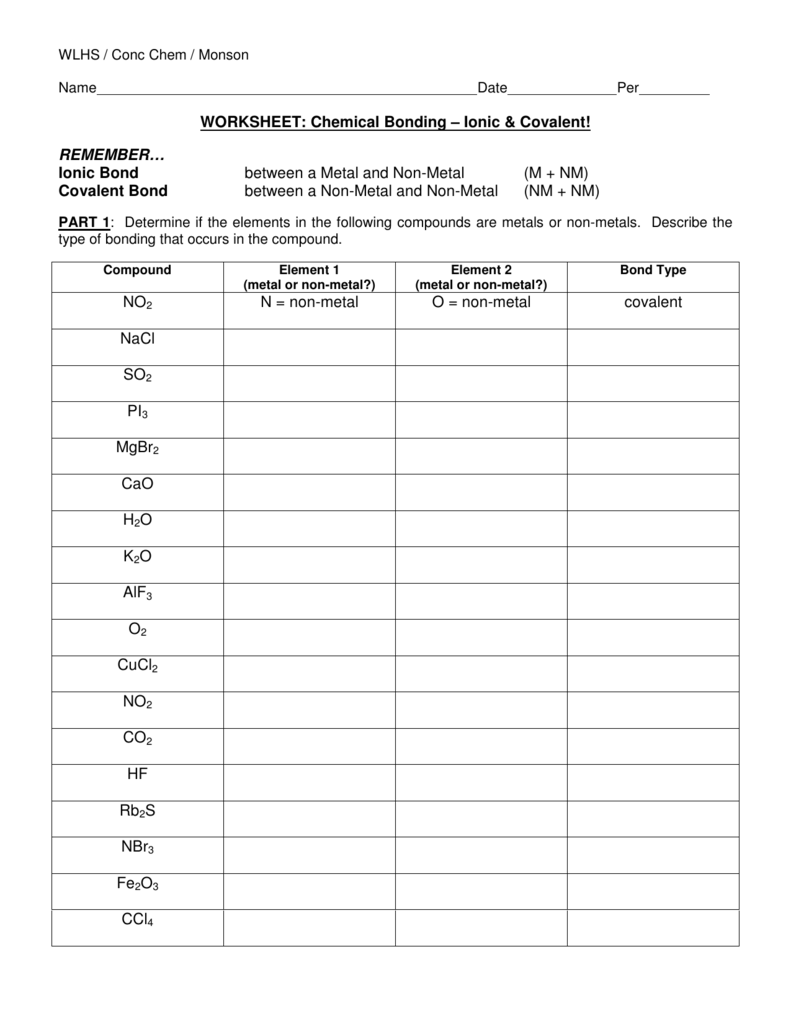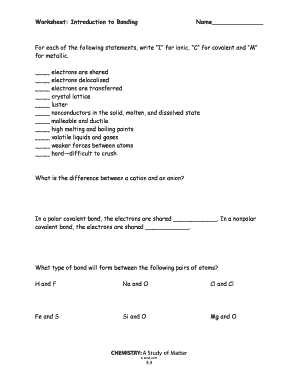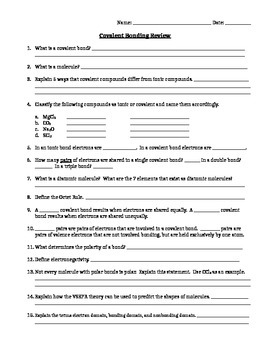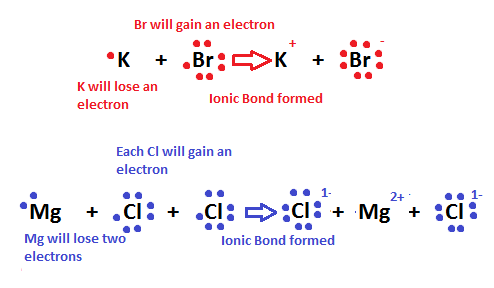40 introduction to bonding worksheet
Introduction to Bonding - New Account Bonding INTRODUCTION Much like people, most atoms don't like to live solitary existences. need to COME TOGETHERwith other atoms to lead more stable, happier lives. This process of coming together is called chemical bonding. Through completing the following Internet Activities, you will learn the characteristics Chemistry Lesson Plans - TeAch-nology.com When Carbons Combine - This lesson is an introduction to organic chemistry, focusing on the use of the word 'organic' in chemistry context and bringing up student's prior knowledge on carbon's bonding characteristics.
20 Positive Psychotherapy Exercises, Sessions and Worksheets Dec 13, 2021 · One positive psychotherapy practice recommended for this session is a positive introduction. A positive introduction is based on principles of Appreciative Inquiry and involves asking a client to recall a positive event in his or her life that ended very well. Positive memories can generate positive emotions and improve mood regulation.

Introduction to bonding worksheet
DOC Chemistry Worksheet Introduction to Chemical Bonding Name Bonding Worksheet #1: Introduction to Ionic Bonds. The forces that hold matter together are called chemical bonds. There are four major types of bonds. We need to learn in detail about these bonds and how they influence the properties of matter. The four major types of bonds are: I. Ionic Bonds III. Metallic Bonds. II. Covalent Bonds IV. 5 MCQ Worksheets on Chemical Bond [MCQ] - Ionic, Covalent ... MCQ worksheet on an introduction to chemical bonds (with answer) - set 1. Subscripts in a chemical formula are used to show the number of. a. molecules in a substance. b. atoms of each element in a compound. c. different elements in a compound. d. protons in an element. PDF Introduction to Bonding BONDING Notes bonding Introduction to Bonding • A good predictor for which type of bonding will develop between a set of atoms is the difference in their electro-negativities. - Remember, electro-negativity is a measure of the attraction an atom has for e-s after developing a bond • The more extreme the difference between the two atoms, the less
Introduction to bonding worksheet. Molecule Shapes - VSEPR | Lone Pairs | Bonds - PhET ... Explore molecule shapes by building molecules in 3D! How does molecule shape change with different numbers of bonds and electron pairs? Find out by adding single, double or triple bonds and lone pairs to the central atom. Then, compare the model to real molecules! PDF A Guide to Chemical Bonding - Mindset Learn Worksheets and questions based on video lessons can be used as short assessments or exercises ... Introduction to Chemical Bonding The focus is on the concept of generating new substances with new physical and chemical properties on a microscopic level. The evidence on the Periodic Table is Introduction to Ionic & Covalent Bonding - PhET Contribution Download all files as a compressed .zip. Title. Introduction to Ionic & Covalent Bonding. Description. Use simulation to observe properties of ionic and molecular compounds in conjunction with MSDS sheets. This is meant to introduce ionic and covalent bonding as well as the properties associated with the resulting compounds. Duration. 60 minutes. Segment A: Introduction to Bonding | Georgia Public ... Segment A: Introduction to Bonding Chemistry Matters Unit 4: Bonding This segment introduces the concept of chemical bonding and explores chemical changes using the ingredients found in taco sauce as a model. Support Materials Standards Vocabulary Segment A: Introduction to Bonding From Chemistry Matters , Unit 4 Segment A: Introduction to Bonding
PDF Introduction to Ionic Bonds I. Ionic Bonds III. Metallic ... 1 Introduction to Ionic Bonds The forces that hold matter together are called chemical bonds. There are four major types of bonds. We need to learn in detail about these bonds and how they influence the properties of matter. The four major types of bonds are: I. Ionic Bonds III. Metallic Bonds II. Covalent Bonds IV. Chemistry worksheet introduction to chemical bonding ... Chemistry worksheet introduction to chemical bonding. STUDY. Flashcards. Learn. Write. Spell. Test. PLAY. Match. Gravity. Created by. Emma5432. NFHS Honors Chemistry Chemical Bonding Unit. Terms in this set (63) Ionic. Bonding found in a compound of an active metal with an active nonmetal. Metallic. Found in an alloy. DOC Chemistry Worksheet Introduction to Chemical Bonding Name Worksheet #4: Introduction to Covalent Bonds A covalent bond is formed between nonmetal atoms. The nonmetals are connected by a shared pair of valence electrons. Remember, nonmetals want to gain valence electrons to reach a stable arrangement. DOC Come Together: Chemical Bonding Worksheet Bonding Comparison Chart IONIC COVALENT METALLIC Types of Atoms Involved (Metal, Nonmetal) Metals and nonmetals Nonmetals Metals and metals Method of Bond Formation (Valence Electrons) Positive ions bonding with negative ions…Transfer of Electrons Sharing valence electrons Valence electrons are shared among atoms…A Sea of Electrons
Introduction To Bonding Worksheets - Learny Kids 1. WordPress at LPS | Sites for LPS Staff & Schools 2. Chapter 4 { Ionic Bond 3. INTRODUCTION TO CHEMICAL BONDING 4. University of Texas at Austin 5. Atomic Structure and Chemical Bonds 6. COVALENT 7. Chapter 8 Covalent Bonding Worksheet Answer Key 8. Icebreakers, Team Building Activities, and Energizers Introduction to Bonding | Introduction to Chemistry Chemical bonds are forces that hold atoms together to make compounds or molecules. Chemical bonds include covalent, polar covalent, and ionic bonds. Atoms with relatively similar electronegativities share electrons between them and are connected by covalent bonds. Atoms with large differences in electronegativity transfer electrons to form ions. PDF Worksheet Introduction To Bonding Answers Bonding Worksheet #1: Introduction to Ionic Bonds. The forces that hold matter together are called chemical bonds. There are four major types of bonds. We need to learn in detail about these bonds and how they influence the properties of matter. The four major types of bonds are: I. Ionic Bonds III. Metallic Bonds. Covalent Bonding Worksheet Answer Key Covalent Bonding Worksheet Answer Key. During a actinic reaction: Energy is captivated to breach bonds. Bond-breaking is an endothermic process. Energy is appear back new bonds form. Bond-making is an exothermic process. Whether a acknowledgment is endothermic or exothermic depends on the aberration amid the activity bare to breach bonds and the activity appear back new bonds form.
Chemical Bonding Activity Teaching Resources | Teachers ... Chemical Bonding Activity Bundle - Ionic, Covalent and Polar Covalent Compounds. by. Big Picture Teaching. 7. $6.00. $4.50. PDF. This chemical bonding bundle of activity worksheets contains the resources for Ionic Bonding, Covalent Bonding and Polar Covalent Bonds in the form of Doodle Notes, all in one purchase.
PDF Chemistry A Bonding - Weebly Worksheet #4: Introduction to Covalent Bonds A covalent bond is formed between nonmetal atoms. The nonmetals are connected by a shared pair of valence electrons. Remember, nonmetals want to gain valence electrons to reach a stable arrangement.
Chemistry 501: Introduction to Bonding | Georgia Public ... Intro to Bonding Worksheet Chemistry: A Study of Matter Episode Semester 1 Chemistry is the study of matter, its composition and the changes it undergoes. During this semester, you will be introduced to the scientific method used to study matter and will be given the mathematical tools you will need for the remainder of the course.
Quiz & Worksheet - Structural Isomers | Study.com About This Quiz & Worksheet. ... Hydrogen Bonding, Dipole-Dipole & Ion-Dipole Forces: Strong Intermolecular Forces Quiz ... Go to Introduction to Organic Chemistry for the MCAT: Help and Review Ch 53.
PDF Introduction to Bonding(5.1) & Ionic Bonding(5.2) Pre-AP Chemistry—Worksheet #1 Date Introduction to Bonding(5.1) & Ionic Bonding(5.2) 1. What type of atoms combine to form a covalent bond? 2. What type of atoms combine to form an ionic bond? 3. What type of atoms combine to form a metallic bond? 4. State the Octet Rule. 5. How does a covalent bond differ form an ionic bond? 6.
Introduction to Bonding Worksheet for 9th - 12th Grade ... Introduction to Bonding In this chemistry worksheet, students create new and true statements while replacing false ones in order to properly define parts of the concept of bonding. 21 Views 69 Downloads Concepts chemical bonds Additional Tags chemical bonding, Chemistry, Physical Science, science Classroom Considerations
Ionic Bonds Worksheets - K12 Workbook Worksheets are Ionic bonding work 1, Chapter 14 ionic bonds work, Bonding basics, Ionic and covalent bonding work with answers, Work 1 introduction to ionic bonds answers, Chemical bonds ionic bonds work, Ionic and covalent bonds work answer key, Ionic bonding work chemistry if8766. *Click on Open button to open and print to worksheet.
PDF WORKSHEET 5.1: BONDING INTRODUCTION - Weebly Chemistry 20 Worksheets 1 WORKSHEET 5.1: BONDING INTRODUCTION NAME: _____ DATE: _____ 1. Which groups of elements in the periodic table of elements will form a. network covalent compounds - compound made of C and Si
PDF Worksheet: Introduction to Bonding Name In a polar covalent bond, the electrons are shared _____. In a nonpolar covalent bond, the electrons are shared _____. What type of bond will form between the following pairs of atoms? H and F Na and O Cl and Cl Fe and S Si and O Mg and O
DOC Chemistry Worksheet Introduction to Chemical Bonding Name Worksheet #2: Introduction to Covalent Bonds A covalent bond is formed between nonmetal atoms. The nonmetals are connected by a shared pair of valence electrons. Remember, nonmetals want to gain valence electrons to reach a stable arrangement.
Worksheet Introduction To Bonding Answer Key - Free PDF ... Worksheet Introduction to Solutions ANSWER KEY Worksheet u2013 Introduction to Solutions Part I- The Basics: 1. Define the following terms: a. ... (In terms of bonding, what 2 types of substances [Filename: Answers_2011_Wksht_Intro_to_Solutions.pdf] - Read File Online - Report Abuse
Copy of Introduction to Ionic & Covalent Bonding.docx ... Introduction to Ionic & Covalent Bonding Student Exploration Worksheet Analysis Questions 1. Based on the chemical formulas and data results, state whether the substances tested above are covalent or ionic. Water and sugar are covalent Salt is ionic
PDF Introduction to chemical bonding worksheet 6.1 answers Introduction to chemical bonding worksheet 6.1 answers In order to continue enjoying our site, we ask that you confirm your identity as a human. Thank you very much for your cooperation. By the end of this section, you will be able to: Derive chemical equations from narrative descriptions of chemical reactions.
Austin Teixeira - 5-05 -Intro to Bonding Wkst.pdf ... View Austin Teixeira - 5-05 -Intro to Bonding Wkst.pdf from AA 1Worksheet: Introduction to Bonding Name_ For each of the following statements, write "I" for ionic, "C" for covalent and "M" for
PDF Introduction to Chemical Bonding UNIT 6 - CHEMICAL BONDING Notes & Worksheets - Honors 1 INTRODUCTION TO CHEMICAL BONDING I. Types of Chemical Bonding A. _____: mutual electrical attraction between the nuclei and valence e- of different atoms that binds the atoms together B. Why do atoms bond together? 1.
PDF Introduction to Bonding BONDING Notes bonding Introduction to Bonding • A good predictor for which type of bonding will develop between a set of atoms is the difference in their electro-negativities. - Remember, electro-negativity is a measure of the attraction an atom has for e-s after developing a bond • The more extreme the difference between the two atoms, the less
5 MCQ Worksheets on Chemical Bond [MCQ] - Ionic, Covalent ... MCQ worksheet on an introduction to chemical bonds (with answer) - set 1. Subscripts in a chemical formula are used to show the number of. a. molecules in a substance. b. atoms of each element in a compound. c. different elements in a compound. d. protons in an element.
DOC Chemistry Worksheet Introduction to Chemical Bonding Name Bonding Worksheet #1: Introduction to Ionic Bonds. The forces that hold matter together are called chemical bonds. There are four major types of bonds. We need to learn in detail about these bonds and how they influence the properties of matter. The four major types of bonds are: I. Ionic Bonds III. Metallic Bonds. II. Covalent Bonds IV.














0 Response to "40 introduction to bonding worksheet"
Post a Comment